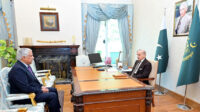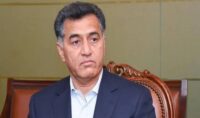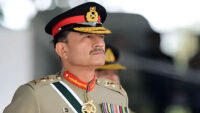India and Pakistan are two countries which are located in the South Asian region and both are neighbours, they both share almost the same history and same culture but a different religion. The rivalry of these two nuclear-weapon states started since the independence when they got free from the British Colonial Raj.
Background
Two of the three main Indo-Pakistani conflicts in 1947 and 1965 and a short war in 1999 originated from disagreements over the Kashmir region. While both nations have maintained a shaky cessation of firing since 2003, they trade fires routinely across the disputed frontier called the Control Line. Both sides accuse the other of a cease-fire breach and say that the attacks are being fired. Dozens of people were murdered and thousands displaced along the Control Line in a hurricane at the border in 2016 and 2018.
AEMEND condemns language used by Maryam Nawaz & Pervaiz Rashid
For more such Opinions, click here!
In 2014, following the invitation of then Indian Prime Minister Modi to attend its inauguration, Pakistan’s then newly elected Prime Minister Nawaz Sharif, there were expectations that the administration of Modi will continue genuine discussions for peace with Pakistan. However, following a brief time of hope, the relationship became harder again in August, after the Pakistani high commissioner in India met with Kashmiri separatist leaders when India postponed meetings with Pakistan’s foreign minister.
During 2015, many openings continued, including an unplanned December meeting on the margins of the United Nations Conference on Climate Change in Paris. A couple of days later, the Kashmir conflict was reviewed at a meeting between the National Security Advisors in Bangkok. Prime Minister Modi visited Lahore later in December in an amazing way to meet Prime Minister Sharif, the first Indian leader visiting Pakistan in more than 10 years.
In September 2016, momentum for serious negotiations ended, when armed terrorists assaulted a remote Indian military outpost in Uri, close to the Control Line, murdering eighty Indian troops in decades in the deadliest attack on the Indian army. Indian officials accused Jaish-e-Mohammad (the primary intelligence agency of Pakistan) of supporting the attack, a group with suspected connections to inter-services intelligence. The Indian army later stated that in September 2016 it was engaged in ‘surgical strikes.’ The Indian Army denied any such operations on terrorist camps in Pakistani-controlled areas along the Control Line.
In October 2017, the military started attacks on the Indian paramilitary camp close to Srinagar, as well as on the Indian Army facility in the Jammu area in February 2018, which murdered five soldiers and a civilian. These assaults occurred during a period of increasing cross-border shelling along the Control Line, with over 3,000 breaches documented in 2017 and around 1,000 in the first half of 2018. In 2017, nearly 300 people, including civilians, Indian security personnel, and terrorists were shot down in assaults and skirmishes and violent rallies and marches to seek the independence of Kashmir also persisted. India declared in May 2018 that it will for the first time observe a cessation of firing in Kashmir during the month of Ramadan in around two decades; the operations were restarted in June 2018 after months of Indian military operations aimed at both Kashmiri terrorists and protestors. In May 2018, India and Pakistan agreed to a cessation of firing along the contested Kashmir border, restoring the conditions of the 2003 accord.
The divert from Afghanistan to Kashmir of Islamist fighters and proxy organizations threaten to generate further border bloodshed. If the attack of Lashkar e Tayyiba was carried out by Pakistan’s terrorist proxies in 2008, where fighters struck the city for four days, killing 164 people, then a serious military conflict between both nuclear-armed powers may be sparked.[1]
BioNTech to develop mRNA-based single shots
Modi regime and Indo-Pak relations
Narendra Modi has achieved a historic triumph in the presidency of India’s Prime Minister and his Party, the Bharatiya Janata Party (BJP), which has gained a further greater majority of the Indian party since 1984. The topic of how Modi approaches the bilateral relations between India and Pakistan during his second term became a matter of considerable interest not just among Indian and Pakistani experts, but also worldwide South Asian political watchers. This piece presents possible scenarios for the future of the India-Pakistan bilateral relations for Modi’s second term and argues that it is necessary to improve the ties among both nuclear-armed neighbours to resolve historic discord at a time of disintegration and international disruption in South Asia.
In his previous period, Modi attempted to strengthen relations with Pakistan with an invitation for his 2014 ceremony to Prime Minister Nawaz Sharif and visited Lahore on Christmas Day 2015 for an unexpected visit. After the Pathankot Assault in January 2016, its government, by connecting dialogue with Islamabad to action on the part of New Delhi thought to be culpable for the attack, reversed the scheduled discussions with Pakistan. In response to an insurgent attack on its military station in Uri, India went through ‘surgical strikes’ within Pakistan-administered Kashmir.
ISPR: Two Terrorists left dead in South Waziristan
As India started its air attacks against supposed terrorist facilities on Pakistani soil that New Delhi said were behind an attack against the Indian paramilitary convoy in Pulwama earlier that month, tension increased in February 2019. Pakistan ransacked the commencement of air attacks in Kashmir, managed by India, followed by air struggles seized by Pakistan by the Indian Air Force’s Abinandan Varthaman. After several days of insecurity and animosity, things ended up easing when Pakistan took Varthaman back to India with a show of peace.
In the campaign for the Indian election to the Lok Sabha earlier this year, post-Pulwama acrimony was evident. Like past elections, this was also full of direct and indirect rhetoric against Pakistan, Modi’s claiming that India is no longer frightened of nuclear threats from Pakistan and that India’s nuclear arms are not only a demonstration. However, the chances for participation seem encouraging after the election. In May, during the Shanghai Cooperation Organization (SCO) Council of Foreign Ministers conference in Kazakhstan, Foreign Ministers from both countries informally met. Moreover, Prime Minister Imran Khan recently revealed the results of the Indian elections, calling Modi to compliment him and expressing the desire to enhance bilateral relations. Modi reaffirmed his earlier recommendation that he should work together to combat poverty, further cooperate and create a climate free of violence and terrorism. More lately, Indian authorities have been cited as recognizing Pakistan’s significant actions against anti-India militant organizations by Indian media outlets which imply that dialogue is about to be opened.
Pakistan envoy Zaheer A Janjua commemorates Kashmiris’ Right to Self Determination Day
For the relationship between India and Pakistan, the next 12 to 18 months would be critical as the recent history bears witness to good gestures from any new Indian administration in the first few months of the tenure of Kashmir, which is the primary bone of contention between India and Pakistan. Due to a mutual antagonism between the two nations, the future character of their bilateral ties can be shaped by one of three probable scenarios. First, one option is that during Modi’s second term, the status quo would continue without any grave interaction between the two nations, while violence remains confined to the control line (LoC). However, following the sequence of moving above stated, such as the phone contact between Khan and Modi, which suggests a connection between the two, this scenario appears implausible.
Secondly, ties might further worsen between the two nations. If the Modi administration continues to embrace policies that see Pakistan isolating as an effort, the probability of such a situation is increased. Examples of this are India’s non-engagement, either bilaterally or multilaterally, with Pakistan since the December 2017 National Security Advisors negotiations, its withdrawal from Pakistan of the most-favored-nation status, Pakistan’s 2016 SAARC boycott, and the association between sports activity and the political nature of the relationship.
Australia cancels Novak Djokovic’s visa following “failure to meet entry requirements”
The third possibility involves some improvement in the bilateral relationship. This could take numerous possible forms, including Pakistan’s actions against insurgent outfits against India, ending proxy and interlocking insurgent operations, both countries in Afghanistan taking account of each other’s strategic interests, and India joining the Chinese-Pakistan Economic Corridor. The picture depends to a considerable extent on the seriousness of Pakistani and Indian administrations in mending bilateral ties. In addition, this possibility is also brought to light by the participation of external parties, such as the United States and China.
Pakistan’s anti-India crackdown might serve as a start to the restoration, from 2013 and perhaps the march toward peace, of the composite or comprehensive conversation. Contrary to previous attacks, the Imran Khan regime took significant measures against prohibited outfits—local media reports suggest the Kashmir Insurgent Organizations in Pakistan’s offices for the first time in more than three decades have reportedly been sealed and prominent leaders of prohibited outfits detained, including their properties. These actions have led to certain of these organizations being forced into the underground and it is stated that Jaish-e-Muhammad (JeM) has requested his cadres to prepare for “migrants and fresh fighting.” These steps show that Pakistan takes the proscribed groups seriously, and this might persuade India to give negotiations an opportunity.[2]
North Korea successfully tests hypersonic missile
Challenges
Independently of their respective publics, India and Pakistan need improved bilateral relations, argues Ravi Agrawal. Both Modi and Khan will have the burden of ensuring that collaboration is not at the expense of their strategic objectives, he said. Agarwal Both nations should prevent the LoC flare-ups and enhance Kashmir’s human rights. Pakistan and India must explore improving their bilateral connections with foreign terrorist organizations, such as IS and AQIS, who are entering South Asia. The discrepancy between them prevents them from exploiting their full economic potential. Its trading potential is bilateral.[3]
Conclusion
The strategic scenario between India and Pakistan is very important for the South Asian Region. Both countries have a history of wars and rivalry. After the Pulwama crisis, the relations between both states become colder and CPEC and China-Pakistan friendship are also becoming a threat to India. Both countries are trying to defend themselves and going into the arms race which will never end.
Usman Khawaja scores century in memorable knock during 4th Ashes Test
Footnotes
[1] “Conflict Between India and Pakistan,” Global Conflict Tracker, accessed June 29, 2021, https://microsites-live-backend.cfr.org/global-conflict-tracker/conflict/conflict-between-india-and-pakistan.
[2] “3 Scenarios for India-Pakistan Relations Under Modi 2.0,” The Diplomat – The Diplomat is a Current-affairs Magazine for the Asia-Pacific, with News and Analysis on Politics, Security, Business, Technology and Life Across the Region, last modified June 25, 2019, https://thediplomat.com/2019/06/three-scenarios-for-india-pakistan-relations-under-modi-2-0/.
[3] “3 Scenarios for India-Pakistan Relations Under Modi 2.0,” The Diplomat – The Diplomat is a Current-affairs Magazine for the Asia-Pacific, with News and Analysis on Politics, Security, Business, Technology and Life Across the Region, last modified June 25, 2019, https://thediplomat.com/2019/06/three-scenarios-for-india-pakistan-relations-under-modi-2-0/.
For more such Opinions, click here!
US military bases in Japan introduce stricter COVID-19 measures
Bibliography
- “3 Scenarios for India-Pakistan Relations Under Modi 2.0.” The Diplomat – The Diplomat is a Current-affairs Magazine for the Asia-Pacific, with News and Analysis on Politics, Security, Business, Technology and Life Across the Region. Last modified June 25, 2019. https://thediplomat.com/2019/06/three-scenarios-for-india-pakistan-relations-under-modi-2-0/.
- “Conflict Between India and Pakistan.” Global Conflict Tracker. Accessed June 29, 2021. https://microsites-live-backend.cfr.org/global-conflict-tracker/conflict/conflict-between-india-and-pakistan.
https://en.baaghitv.com/distribution-of-student-bag-packs-at-ggps-chachro-baaghi-tv/
Stay tuned to Baaghi TV for more. Download our app for the latest news, updates & interesting content!






